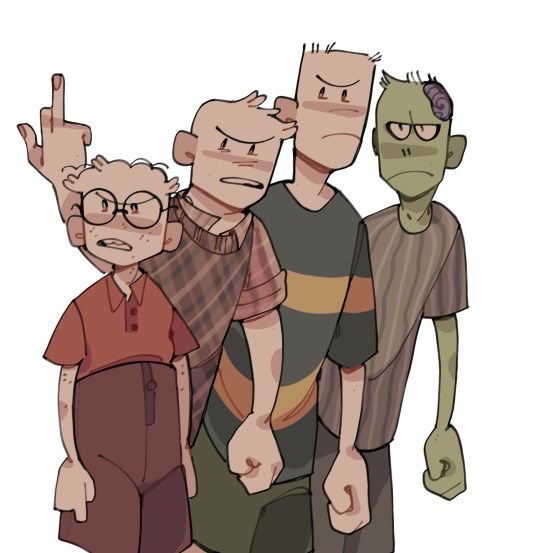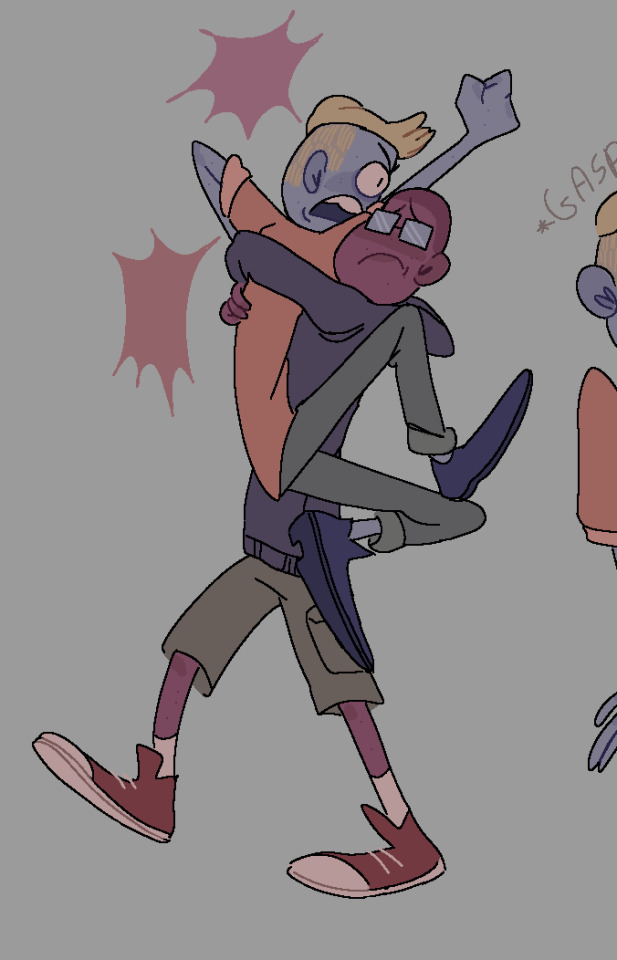#bcg alexander
Explore tagged Tumblr posts
Text










old drawings i decided to post bc why nott!!
włatcy móch <33
#wander over yonder#woy#woy peepers#commander peepers#apple and onion#włatcy móch#konieczko#czesio#maślana#anusiak#big city greens#bcg alexander#bcg terry#alexander x terry#dont hug me im scared
426 notes
·
View notes
Text
Today's LGBT+ Character is;

Alexander and Terry from Big City Greens-Gay
Requested by Anon
Status; Alive and dating
#Alexander BCG#Terry BCG#Big City Greens#gay#lgbt#character of the day#mlm#animated#tv shows#mlm couple#lgbt couple#requested#fandoms i'm not in#LGBTQueue#alive
15 notes
·
View notes
Text

#Big City Greens#BCG#BCG Fanart#Alexander and Terry#Terry and Alexander#Alexander x Terry#Terry x Alexander#Alexander#Terry#Fanart#Gay#Shipping#Gay Representation#Please don't use or repost without permission. Thank you.
1 note
·
View note
Note
hi chris its been like 2 years since my big city greens hyperfixation and i decided to go back on tumblr because twitter sucks
I honestly miss the days where I sat there in my room, binge watching the shows again and again, mentioning it to my friends every 2 minutes and always getting excited when i see terry and alexander (cuz being gay and a teen was hard)
seeing your tumblr against was a blast of nostalgia, i would constantly scroll through this page and waiting for more updates...
big city greens had a huge positive impact on my teenage life and i love the show a lot, you and shane are awesome (and thanks for creating alexander and terry)

Aw man, what a sweet message. I haven't been posting on Tumblr as much these days but I'm glad to hear the old posts still have some value. I'm thrilled to hear you've enjoyed BCG- thank you!
44 notes
·
View notes
Text
Just looked in the tags of that BCG gif and it's very they don't know.gif about Alexander and Terry, a canon gay couple.
3 notes
·
View notes
Photo

Alexander and Terry from BCG
96 notes
·
View notes
Photo

Delivered with Impact
Tuberculosis, caused by the bacterium Mycobacterium tuberculosis (Mtb), is the world’s deadliest infectious disease, responsible for an estimated 1.7 million deaths annually. A vaccine known as BCG provides protection from tuberculosis in infants but is not always successful, particularly in older children and adults, leaving many still vulnerable. To improve the vaccination process, researchers working with rhesus macaques experimented with different doses and methods of administering BCG. While vaccination typically involves a jab through the skin, they found that providing BCG intravenously, straight into the bloodstream, yielded better results. Monkeys vaccinated in this way experienced a greater immune response and fared better when later challenged with Mtb: many displayed no symptoms, and scans of their lungs (pictured, bottom row) revealed much less inflammation (in red) than in subjects vaccinated as usual (top row). Despite some logistical challenges, intravenous delivery could be part of more effective vaccination strategies in the future.
Written by Emmanuelle Briolat
Part of an image by JoAnne Flynn, Ph.D., Alexander White, Pauline Maiello and Mario Roederer, Ph.D.
Vaccine Research Center, National Institute of Allergy and Infectious Diseases (NIAID), National Institutes of Health (NIH), Bethesda, MD, USA
Image copyright held by the original authors
Research published in Nature, January 2020
You can also follow BPoD on Instagram, Twitter and Facebook
#science#biomedicine#tuberculosis#vaccines#vaccinate your kids#get vaccinated#vaccination#bcg#pet-ct#computed tomography
6 notes
·
View notes
Text
Business Model Canvas la gi
Business Model Canvas là một trong những thuật ngữ mà bắt cứ người làm kinh doanh nào cũng sẽ nghĩ đến trong hoạt động xây dựng công ty , nó cũng là một trong những công thức giúp chúng ta đánh giá và thiết lập mô hình công ty dễ dàng.
Trong bài viết này, blog.atpacademy.vn sẽ phân tích về đặc trưng để giải đáp câu hỏi Business Model Canvas là gì và từ đó chúng ta sẽ cùng tìm hiểu hình thức để xây dựng mô hình Business Model Canvas thành công.
Business Model Canvas là gì?
Business Model Canvas (BMC) là một giải pháp xây dựng mô hình bán hàng hiện đại được thiết kế bởi Alexander Osterwalder và Yves Pigneur. Trong cuốn sách Business Model Generation, hai ông đã mô tả đây là một mô hình kinh doanh gồm có 9 thành tố ứng với 9 trụ cột thiết lập tổ chức của một tổ chức. Mục đích quan trọng của nó là gúp doanh nghiệp thống nhất những quy trình bán hàng bằng cách minh họa các tiêu chuẩn đánh đổi tiềm năng.
bằng cách đơn giản hóa những bản chiến lược bán hàng dày cộp theo một cách trực quan và dễ hiểu, mô hình trên đã được hưởng ứng rộng khắp trong giới bán hàng vì lợi ích và thành công mà nó mang tới . Hiện tại, rất nhiều doanh nghiệp tại Việt Nam đã áp dụng mô hình bán hàng Canvas để đo lường hiện trạng công ty và tìm ra phương pháp tạo lợi nhuận tối ưu.
9 trụ cột trong mô hình kinh doanh Canvas đại diện cho 4 mặt quan trọng của một đơn vị ( người sử dụng, hiệu quả , cơ sở vật chất và năng lực tài chính), bao gồm :
phân khúc khách hàng (Customer Segments)
phương án giá trị (Value Propositions) Kênh cung cấp (Channels
Quan h�� người dùng (Customer Relationships)
Dòng doanh thu (Revenue Stream)
nguồn tiềm lực chính (Key Resources)
công việc chính (Key Activities)
Đối tác chính (Key Partnerships)
Cơ cấu chi phí (Cost Structure)
>> Đọc thêm: Ma trận BCG là gì tại đây https://amis.misa.vn/62056/ma-tran-bcg-la-gi/
Điểm mạnh của Business Canvas Model
Business Canvas rất phổ biến với những chủ doanh nghiệp và những nhà lãnh đạo nhằm mục tiêu cải tiến mô hình kinh doanh. Về căn bản có 3 ưu thế không thể thiếu.
Tập trung: con người đang loại bỏ 50+ trang giấy viết kế hoạch bán hàng truyền thống và ngày càng nhiều những doanh nghiệp nổi tiếng trên thế giới sử dụng
Linh động: Khi mọi thứ được viết trên một trang giấy, ta có thể thay đổi và nghiên cứu Tất cả mọi thứ dễ dàng hơn rất nhiều.
Bài bản: cộng sự của bạn sẽ mất ít thời gian để đọc và nắm bắt hoạch định kinh doanh của bạn hơn và họ có thể dễ tiếp nhận tầm nhìn của bạn hơn khi Tất cả mọi thứ được bày ra trên một trang giấy.
Tại sao nên dùng mô hình bán hàng Canvas?
Tư duy trực quan: Mô hình kinh doanh Canvas đem đến một cái nhìn trực quan hỗ trợ cho bạn không phức tạp xem xét và đề ra quyết định. Nó đưa ra một bản phân tích gọn gàng về những vấn đề chính ảnh hưởng đến doanh nghiệp và làm cho rõ phương hướng của cơ quan thông qua mô hình.
nhanh chóng, tiện lợi : nếu bạn in mô hình Canvas ra một tấm áp phích, nhân sự có thể dùng những mảnh giấy nhớ để dán lên đó các từ khoá chính và rà soát tác động của chúng tới mô hình bán hàng trong tương lai.
Hiểu được mối quan hệ giữa 9 trụ cột: Mô hình kinh doanh Canvas cho phép bạn nắm bắt được mối liên hệ giữa 9 trụ cột và các giải pháp có ích có thể thay đổi mối quan hệ giữa chúng nhằm cải thiện hiệu suất hoạt động. Với công cụ này, bạn sẽ dễ dàng nghiên cứu cơ hội hoặc phương án cải thiện mới.
Lưu thông đơn giản : Canvas là phương pháp di động thuận tiện , cho phép truy cập và chia sẻ dễ dàng . Bạn sẽ không phức tạp vẽ lại một mô hình Canvas đầy đủ, hoặc không phức tạp là truyền tay nhau giữa mọi người để ai cũng có thể nắm được ý chính cũng như bổ sung thêm thông tin nếu cần thiết.
Tin bài liên quan cùng chuyên mục: MÔ hình kinh doanh b2b của alibaba
0 notes
Text

alexander and terry bc they don't get enough attention >>:(
#big city greens#bcg alexander#big city greens alexander#big city greens terry#bcg terry#alexander x terry#terry x akexander#big city greens fanart#bcg fanart
299 notes
·
View notes
Text
From 'dirty' to 'vintage': luxury embraces second-hand

For years they were like cat and dog. Luxury brands did not want to know anything about the second-hand sale of their clothing and accessories. Too little control, too little exclusive, too much mothball smell. But that period is over now.
The best selection, at the best prices. That is the way the online platform for second-hand designer clothes Grailed[1] praises itself. Vinted[2], but for luxury designer brands, with a focus on men. In a new round of investment, the site raised about $60 million last week.
The major investor is the luxury group Kering[3], that is owned by the Pinault family. Balenciaga, Saint Laurent, Alexander McQueen and Gucci, among others, fall under the umbrella of the group. On Friday, Gucci also announced its new online concept store: in addition to new pieces, Vault also offers vintage, selected by Gucci designer Alessandro Michele. Gone are the days when luxury houses turned their noses up at vintage.
“Second-hand has always existed, although luxury houses have long resisted it,” says Emmanuelle Dirix, lecturer in fashion history and culture at the Academy in Antwerp. It is not illogical that large fashion houses did not want to know about it: brands that live on luxury and exclusivity were not set up with the idea that you could buy a 'real' design for less money.
In 2018, Chanel even filed a lawsuit against What Goes Around Comes Around[4]. The company, that sells second-hand clothing and accessories from luxury brands, lived on the reputation of luxury brands, according to Chanel. The brand denounced that counterfeits as 'true vintage' were also sold on the site – something that has been an thorn in the flesh of many luxury brands for years.
But the time when second-hand is 'dirty' is long gone. A younger generation that wants to buy brands is looking to second-hand online. The Realreal[5], Depop[6], Grailed, Vestiaire Collective[7]: online platforms for second-hand luxury goods have sprung up like mushrooms in recent years. A Boston Consulting study[8] estimates the industry's annual growth rate at 12 percent. In that context, the 3 percent growth of the 'normal' luxury segment appears to be small beer. Dirix: 'Simply put: if you can't beat them, join them'.
Fake
It also gives brands the opportunity to have more control over the second-hand sales of their own products. Grailed is working on an online authentication system, other sites such as Vestiaire Collective and Goat[9] work with 'specialists' who have to check items to prevent counterfeiting.
This is done by looking at the workmanship – so you need a small army of specialists – or by examining the labels in each item, where you can find out whether something is real on the basis of a type of 'serial numbers'. “But those databases are of course largely held by the brands, especially with older collections,” says Dirix.
More than that, it gives brands access to another market: young people who may not go to the Gucci store, but do buy brands online. Especially if it can be done cheaper. And even more valuable is that brands have access to a wealth of information about a younger clientele: what does a younger generation want, and which former pieces are worth dating up. Many sites such as Grailed are established for and by people who resell second-hand. That information is worth its weight in gold for many brands. Brands immediately adopt a new and greener image', thinks Dirix.
Surplus
Speaking of ecology, second-hand platforms are an excellent way for luxury brands to get rid of their unsold stock, Dirix thinks. Many luxury brands do not hold sales, for fear of destroying their own market. The only way to get rid of their surplus stock is through internal sales for their own staff – often with a maximum budget per employee, to avoid the clothing ending up en masse on the second-hand market.
Moreover, brands cannot and may not just destroy their unsold items. Especially since 2018, when it turned out that Burberry had burned $37 million worth of stuff in July that year, that has been monitored. In France it is even prohibited by law.
"I suspect that luxury concerns such as Kering may see a solution in this to get rid of those unsold items," says Dirix. ‘What is not sold now will be “vintage” in a few years. That might provide an answer to a very thorny issue for them.”
However, the prices on the second-hand sites are also not nothing: on Vault[10] you can quickly count 800 euros for a vintage Gucci. Dirix: 'Sites like Grailed aim at an audience that has enough purchasing power to buy a trendy vintage dress on a carefully curated platform. The site itself is almost already a “seal of approval”. These people are not fashion fanatics who feel like scouring tired second-hand shops or Ebay to find real gems for no money with a lot of patience and searching.'
Source
Karlien Beckers, Van ‘vies’ naar ‘vintage’: luxe omarmt tweedehands, in: De Standaard, 28-09-2021
[1] At its core, Grailed is a simple concept: It's a website and app for buying and selling high-end, secondhand menswear and streetwear. But the site offers much more. One can buy a piece one has been searching high and low for, stock up on basics one needs for the office, and discover new brands all in the same place. Grailed: Largest Online Marketplace to Buy & Sell Menswear [2] Vinted is an online marketplace based in Lithuania for buying, selling and exchanging new or secondhand items, mainly clothing and accessories. https://old.vinted.com/ [3] A global Luxury group, Kering manages the development of a series of renowned Houses in Fashion, Leather Goods, Jewelry and Watches: Gucci, Saint Laurent, Bottega Veneta, Balenciaga, Alexander McQueen, Brioni, Boucheron, Pomellato, Dodo, Qeelin, Ulysse Nardin, Girard-Perregaux, as well as Kering Eyewear. Luxury Group Kering | Kering | Kering [4] Since 1993, when it opened its first store In New York City’s SoHo neighborhood, What Goes Around Comes Around (WGACA) has elevated traditional vintage shopping Into a high fashion experience. With additional flagships In Beverly Hills, WGACA Is an international destination for tastemakers, industry insiders and celebrities alike. What Goes Around Comes Around - Home (whatgoesaroundnyc.com) [5] The RealReal, Inc. is an online and brick-and-mortar marketplace for authenticated luxury consignment. Based on the circular economy, The RealReal sells consigned clothing, fine jewelry, watches, fine art and home decor. It employs an in-house staff of experts including horologists, gemologists, art curators and luxury fashion authenticators who inspect items for authenticity and value. https://www.therealreal.com/ [6] https://www.depop.com/ [7] https://fr.vestiairecollective.com/ [8] “The secondary market for luxury goods has always existed in the shadow of the primary market,” according to a report from the Boston Consulting Group, but that is beginning to change as demand for discounted pre-owned goods is giving rise to “one of the fastest-growing areas of luxury.” The management consulting firm estimates that luxury resale will grow at an average rate of 12 percent per year through 2021 to a whopping $36 billion market with a 9 percent share of the personal luxury goods segment. That is quite a bit larger than the 3 percent growth rate for the primary luxury market for that same period of time. The Luxury Resale Market is Growing Faster than the Primary Luxury Goods Segment, Per BCG - The Fashion Law [9] https://www.goat.com/ [10] Designer clothing has always made its wearer feel good, and Vault menswear has been founded on the core belief that “looking good is feeling good” to people this is not just a strap line, but a principle with its stock of on trend designer clothing such as Pre Londo and the classic heritage brands like Lacoste the company fulfills this through our product. Below is a small sample of the brands the platform offers: Luke1977, Lacoste, EA7, Mark Darcy, Fred Perry, Kings Will Dream, Pre London, Sik Silk Vault Menswear | Mens Designer Clothing | Doncaster
0 notes
Text
Recruitment Process Outsourcing Market Outlook: Competitive Intensity is Higher than Ever | Randstad Holding, Seven Step RPO, Pontoon Solutions
Recruitment Process Outsourcing (RPO) is when a company transfers all or portion of its permanent recruitment to an outside provider. An RPO provider can act as an expansion of a companyâ€

s HR or Resourcing function, sitting on site with the client providing a holistic hiring solution. Recruitment process outsourcing (RPO) has become a vital, adaptable and scalable talent acquisition solution for organizations — of all sizes — designed to progress employer branding, candidate and hiring manager experience, and to make a centralized talent pipeline, in addition to meet hiring demands. RPO isn’t just constrained to hiring individuals but moreover includes the management of individuals, processes, technology, and the talent acquisition procedure. RPO offers extraordinary communication experience to the candidate by giving reliable, transparent, and fair feedback that can help the organization’s reputation sterling. It moreover helps in intensifying the manager brand of the organization.
A Latest intelligence report published by AMA Research with title “Recruitment Process Outsourcing Market Outlook to 2026.A detailed study accumulated to offer Latest insights about acute features of the Global Recruitment Process Outsourcing market. This report provides a detailed overview of key factors in the Recruitment Process Outsourcing Market and factors such as driver, restraint, past and current trends, regulatory scenarios and technology development. A thorough analysis of these factors including economic slowdown, local & global reforms and COVID-19 Impact has been conducted to determine future growth prospects in the global market.
Free Sample Report + All Related Graphs & Charts @: https://www.advancemarketanalytics.com/sample-report/10161-global-recruitment-process-outsourcing-market-2
Major Players in This Report Include,
Seven Step RPO (United States),Saaki, Argus and Averil Consulting(India),Zyoin (India),Randstad Holding Company (Netherland),Pinstripe Inc. (United States),Pontoon Solutions (United States),Futurestep (United States),Accolo Inc. (United States),Alexander Mann Solutions (United Kingdom)
Market Trends:
Increased Adoption of Analytics
Upsurge in the Growth of Analytics BPO Market
Majority of MNCs are Standardizing and Consolidating Payroll Structure
Market Drivers:
Increasing Attrition Rate
Increasing Number of Fresh Graduates and Post Graduates
Increasing Adoption of Web Based Services
Market Opportunities:
Digital Transformation in the BFSI and Telecom Sector
The Global Recruitment Process Outsourcing Market segments and Market Data Break Down are illuminated below:
by Application (BFSI, Healthcare, Telecom, Manufacturing, Others), Type (Partially Outsourced, Fully Outsourced), Enterprise Size (Small & Medium Enterprises (SMEs), Large Enterprises), Service (On-site, Off-site)
Recruitment Process Outsourcing the manufacturing cost structure analysis of the market is based on the core chain structure, engineering process, raw materials and suppliers. The manufacturing plant has been developed for market needs and new technology development. In addition, Recruitment Process Outsourcing Market attractiveness according to country, end-user, and other measures is also provided, permitting the reader to gauge the most useful or commercial areas for investments. The study also provides special chapter designed (qualitative) to highlights issues faced by industry players in their production cycle and supply chain. However overall estimates and sizing, various tables and graphs presented in the study gives and impression how big is the impact of COVID.
Enquire for customization in Report @: https://www.advancemarketanalytics.com/enquiry-before-buy/10161-global-recruitment-process-outsourcing-market-2
Geographically World Recruitment Process Outsourcing markets can be classified as North America, Europe, Asia Pacific (APAC), Middle East and Africa and Latin America. North America has gained a leading position in the global market and is expected to remain in place for years to come. The growing demand for Recruitment Process Outsourcing markets will drive growth in the North American market over the next few years.
In the last section of the report, the companies responsible for increasing the sales in the Recruitment Process Outsourcing Market have been presented. These companies have been analyzed in terms of their manufacturing base, basic information, and competitors. In addition, the application and product type introduced by each of these companies also form a key part of this section of the report. The recent enhancements that took place in the global market and their influence on the future growth of the market have also been presented through this study.
Report Highlights:
Comprehensive overview of parent market& substitute market
Changing market dynamics in the industry (COVID & Economic Impact Analysis)
In-depth market segmentation (Trends, Growth with Historical & Forecast Analysis)
Recent industry trends and development activity
Competitive landscape (Heat Map Analysis for Emerging Players & Market Share Analysis for Major Players along with detailed Profiles)
Strategic Points Covered in Table of Content of Recruitment Process Outsourcing Market:
Chapter 1: Introduction, market driving force product Objective of Study and Research Scope the Global Recruitment Process Outsourcing market
Chapter 2: Exclusive Summary – the basic information of the Global Recruitment Process Outsourcing Market.
Chapter 3: Changing Impact on Market Dynamics- Drivers, Trends and Challenges & Opportunities of the Global Recruitment Process Outsourcing; Post COVID Analysis
Chapter 4: Presenting the Global Recruitment Process Outsourcing Market Factor Analysis, Post COVID Impact Analysis, Porters Five Forces, Supply/Value Chain, PESTEL analysis, Market Entropy, Patent/Trademark Analysis.
Chapter 5: Displaying the by Type, End User and Region/Country 2014-2019
Chapter 6: Evaluating the leading manufacturers of the Global Recruitment Process Outsourcing market which consists of its Competitive Landscape, Peer Group Analysis, BCG Matrix & Company Profile
Chapter 7: To evaluate the market by segments, by countries and by Manufacturers/Company with revenue share and sales by key countries in these various regions (2020-2026)
…………….
Buy this research @ https://www.advancemarketanalytics.com/reports/10161-global-recruitment-process-outsourcing-market-2
Key questions answered
Who are the Leading key players and what are their Key Business plans in the Recruitment Process Outsourcing market?
What are the key concerns of the five forces analysis of the Recruitment Process Outsourcing market?
What are different prospects and threats faced by the dealers in the Recruitment Process Outsourcing market?
What possible measures players are taking to overcome and stabilize the situation?
Thanks for reading this article; you can also get individual chapter wise section or region wise report version like North America, Middle East, Africa, Europe or LATAM, Asia.
Contact US:
Craig Francis (PR & Marketing Manager) AMA Research & Media LLP Unit No. 429, Parsonage Road Edison, NJ New Jersey USA – 08837 Phone: +1 (206) 317 1218 [email protected]
from NeighborWebSJ https://ift.tt/3ztZ63W via IFTTT
from WordPress https://ift.tt/3BAtXh3 via IFTTT
0 notes
Photo

University of Illinois Chicago College of Engineering MIE PhD student Rafael Granda works on research in professor Alexander Yarin’s lab in Chicago, Illinois October 7, 2020. (Photo: UIC Engineering)
UIC reports record $410 million in annual sponsored research awards
The University of Illinois Chicago established a new research record in fiscal year 2020 with sponsored research awards surpassing the $400 million mark for the first time in the university’s history.
The $410 million represents a 7% increase over fiscal year 2019 and 22% increase over fiscal year 2018, and provides support for approximately 9,400 faculty, students and staff working on 1,800 different research projects.
Funding was awarded by a variety of sponsors, including the National Institutes of Health, the National Science Foundation, the U.S. Department of Defense, and many other federal and state funding agencies, as well as foundations and the private sector. The awards supported a wide range of research activities in all UIC’s Colleges and disciplines, from the health sciences and STEM fields, to the social sciences and the arts and humanities.
“The growth of our research portfolio reflects our collective commitment across the university to the creation and application of new knowledge. It further demonstrates our researchers’ dedication and determination to solve some of the world’s greatest challenges and places UIC among the top research universities in the world,” said UIC Chancellor Michael Amiridis.
“This tremendous achievement reflects the hard work and teamwork of our talented laboratory and social scientists, clinician investigators, engineers, data analysts, staff, trainees and others who develop their ideas into discovery,” said Joanna Groden, UIC’s Vice Chancellor for Research. “It also reflects the commitment of our administrative staff to support the needs of our researchers as they translate these ideas into funding for their work.”
Funded projects include a $3.6 million from the National Institutes of Health for the continued support for UIC’s Clinical and Translational Science efforts, a $2.5 million grant from the National Science Foundation to improve undergraduate STEM engagement in environmental sciences, physiology and chemistry using the study of the Monarch butterfly, and a $1.3 million grant from the U.S. Department of Education to mentor Latinx students in successfully earning degrees in STEM fields.
Other highlights include:
Curating ‘’American Framing,” the U.S. Pavilion Exhibition at the 17th Venice Architecture Biennale ($400,000 award from the U.S. Department of State).
Developing and providing assistive technologies to people with disabilities ($1.25 million award from the State of Illinois Department of Human Services).
Assessing the association of chronic eye disease in Hispanic/Latino groups with cardiovascular disease and sociocultural risk factors in an ongoing NIH-funded Hispanic Community Health/Study of Latinos ($2.2 million one-year supplement award from the National Institutes of Health).
Encouraging more women to pursue computing careers through curriculum, career and community-building activities ($1.1 million award from Pivotal Ventures and Cognizant U.S. Foundation).
Identifying biomarkers associated with Niemann-Pick Type C, an inherited neurodegenerative disease using state-of-the-art mass spectrometry ($1.3 million from the Together Strong NPC Foundation).
Studying glucose metabolism in type 1 diabetes patients during phases of the menstrual cycle ($2 million award from the Juvenile Diabetes Research Foundation).
Constructing a beamline to expand chemistry and materials research capability through a partnership with the Argonne National Laboratory ($14 million from the National Science Foundation).
“Federal funding, which accounts for nearly 75% of UIC’s research volume in FY20, is critically important to our research activity and is the primary source of our funding,” said Groden. The National Institutes of Health (NIH) was the largest UIC research sponsor in FY20, providing over $169 million in funding. This includes support for 155 active R01 grants, indicating the strength and breadth of UIC’s research in the health sciences. The active R01 projects range from studying the plasticity circuits in Alzheimer’s disease to using botanical dietary supplements as alternatives to hormone replacement therapy for women’s health, to improving blood pressure with resistance exercise in African Americans.
UIC faculty have also received a significant number of Faculty Early Career Development Program (CAREER) awards from the National Science Foundation (NSF) — 18 in the 2020 funding cycle — designed to help rising U.S. researchers and scholars establish long-term leadership through the integration of research and education. Their projects span from the development of reactive electrochemical membranes for sustainable water treatment to researching lipid transport in membranes. The success of UIC’s junior faculty in this area is a strong indicator for the continuing growth of the university’s research endeavors.
As expected, in recent months UIC researchers have also focused on COVID-19-related work and were awarded over $32 million in funding in this area ($8.4 million in FY20 and over $24 million so far in FY21). Highlights include:
Clinical trials for the Moderna and Janssen vaccines and the Regeneron and Eli Lilly monoclonal antibody drugs.
Piloting a program to use convalescent plasma to treat COVID-19 patients.
Creating a Hero Registry for participation in the national Healthcare Worker Exposure and Outcomes Registry.
Testing the efficacy of saliva home tests to measure potential outbreak hotspots.
“Our clinical researchers at UIC have addressed the urgent need for new therapeutic approaches to care for those infected by COVID-19, and to prevent infection with vaccine studies,” said Groden. “UIC researchers of all types continue to generate the tools and the processes needed to address the pandemic’s effects on so many, while others work to understand the disease mechanisms of the pathogen.”
In FY20, UIC also reported 580 patents issued, 289 active licenses of its intellectual property, $50 million in licensing income, and 26 new startups associated with UIC’s research. Currently, UIC has three major therapeutics on the market licensed to major pharmaceutical companies, including Prezista, an anti-HIV drug (Janssen Therapeutics); Tice BCG, a bladder cancer drug (Merck); and Shingrix, the world-leading vaccine for shingles (Glaxo Smith Kline).
#research funding#COVID vaccine#university research#convalescent plasma#Hero Registry#saliva home tests#Latinx students#glucose metabolism#Venice Architecture Biennale#assistive technologies#chronic eye disease#Argonne National Laboratory#biomarker
0 notes
Text
Administering TB vaccine intravenously could improve efficacy

- By Nuadox Crew -
Globally, more people die from tuberculosis (TB) than any other infectious disease, in spite of many individuals being vaccinated. The vaccine may not be always reliable. However, a new Nature study finds that simply changing the way the vaccine is administered could boost its protective power.
Researchers at the University of Pittsburgh School of Medicine and the National Institute of Allergy and Infectious Diseases (NIAID) discovered that intravenous TB vaccination is highly protective against the infection in monkeys, compared to the standard injection directly into the skin, which offers minimal protection.
"The effects are amazing," said senior author JoAnne Flynn, Ph.D., professor of microbiology and molecular genetics at the Pitt Center for Vaccine Research. "When we compared the lungs of animals given the vaccine intravenously versus the standard route, we saw a 100,000-fold reduction in bacterial burden. Nine out of 10 animals showed no inflammation in their lungs."
Flynn's team tested several routes and doses of the only commercially available human TB vaccine, Bacille Calmette-Guérin (BCG), which is made of a live, weakened form of TB bacteria found in cattle.
The BCG vaccine has been around for 100 years and is among the most widely used vaccines in the world, but its efficacy varies widely.
The idea for an intravenous TB vaccination came from earlier experiments by the other senior author on the study, Robert Seder, M.D., at the NIAID's Vaccine Research Center. Seder showed in both animals and humans that the malaria vaccine is more effective when delivered intravenously.

Image: 3D PET CT scans of monkey lungs showing inflammation (red and yellow) from TB infection. The top row were vaccinated the usual way with a shot into the skin The bottom row received the vaccine intravenously. Credit: JoAnne Flynn, Ph.D., Alexander White, Pauline Maiello, and Mario Roederer, Ph.D.
To test whether the method of administration matters for TB, Flynn and colleagues separated their colony of monkeys into six groups: unvaccinated, standard human injection, stronger dose but same injection route, mist, injection plus mist, and finally, the stronger dose of BCG delivered as a single shot directly into the vein.
Six months later, the researchers exposed the animals to TB and monitored them for signs of infection.
Monkeys are extremely susceptible to TB. All of the animals who received the standard human dose had persistent lung inflammation, and the average amount of TB bacteria in their lungs was only slightly less than in the monkeys who received no vaccine at all. The other injected and inhaled vaccines offered similarly modest TB protection.
The intravenous vaccine, on the other hand, offered nearly full protection. There was virtually no TB bacteria in the lungs of these animals, and only one monkey in this group developed lung inflammation.
"The reason the intravenous route is so effective," Flynn explained, "is that the vaccine travels quickly through the bloodstream to the lungs, the lymph nodes and the spleen, and it primes the T cells before it gets killed."
Flynn's team found BCG and activated T cells in the lungs of all the intravenously vaccinated animals. Among the other groups, BCG was undetectable in the lung tissue and T cell responses were relatively meagre.
Next, the researchers plan to test whether lower doses of intravenous BCG could offer the same level of protection without the side effects, which mostly consist of temporary inflammation in the lungs.
But before this method can be translated to humans, researchers need to know that it's not only safe, but also practical. An intravenous vaccine requires more skill to administer and carries a higher risk of infection.
"We're a long way from realizing the translational potential of this work," Flynn said. "But eventually we do hope to test in humans."
Source: University of Pittsburgh
Read Also
Microneedle patch improves flu vaccines
MIT developing a new way of delivering multiple vaccine doses
0 notes
Note
favorite character on bcg? :O

my boy alexander!!
cricket is cool too<33
74 notes
·
View notes
